

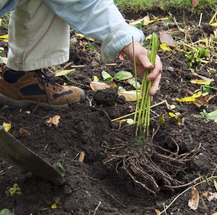
Late October and we are getting a few days of summer-like weather. 15 C here yesterday, great for gardening. I have been cleaning up the two large perennial beds in the back. They contain the Asparagus plants. One bed has been producing a considerable number of quite skinny spears that last few years. Two years ago I planted some new seeds of an all male variety, (they have the fatter spears,) in another corner of the garden. It was time to dig out the skinny roots and replace them with the two year old new roots. Not an easy job; Asparagus develops rather significant root systems over the ten years or so that mine have been in place. It is done and the beds have been thoroughly cleaned up as a result. They now await this weeks planting of new bulbs. 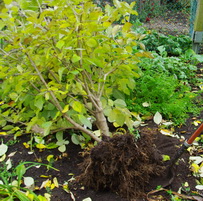 There is a large and getting larger, Preston Lilac bush in the back yard. I planted it at a curve in my garden path as a way of blocking a wanderer’s sight lines, thus drawing them deeper into the garden. It works. It has to move. The Assistant Gardener has suggested that I didn’t consider all of the planning parameters when I chose its location. I didn’t look up and it seems to be directly under the clothesline and is now tall enough to conflict. Since it also has chosen not to bloom for the three years, that it has been leaving green marks on the clean laundry, it is getting a new home . Autumn is a great time to move deciduous trees and shrubs. As soon as their leaves start to turn colour, dig them up. They will still make significant root growth in their new location without having to support a canopy of leaves.
There is a large and getting larger, Preston Lilac bush in the back yard. I planted it at a curve in my garden path as a way of blocking a wanderer’s sight lines, thus drawing them deeper into the garden. It works. It has to move. The Assistant Gardener has suggested that I didn’t consider all of the planning parameters when I chose its location. I didn’t look up and it seems to be directly under the clothesline and is now tall enough to conflict. Since it also has chosen not to bloom for the three years, that it has been leaving green marks on the clean laundry, it is getting a new home . Autumn is a great time to move deciduous trees and shrubs. As soon as their leaves start to turn colour, dig them up. They will still make significant root growth in their new location without having to support a canopy of leaves.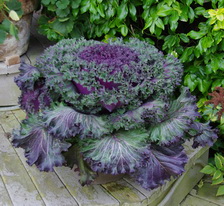 All of this week’s gardening chores have been, delightfully, slowed by making sure that the cordless telephone is always in the garden cart or in my pocket. Grandchild number 8 is due to make her arrival into the world at any time now and I don’t want to miss that call.
All of this week’s gardening chores have been, delightfully, slowed by making sure that the cordless telephone is always in the garden cart or in my pocket. Grandchild number 8 is due to make her arrival into the world at any time now and I don’t want to miss that call. Last week a good friend gave me a large pot of flowering kale. Those pretty purple plants that we use as autumn container subjects. She gave me more than she planned to. The leaves of these plants hold a lot of rain water and when I tipped it over to move it, a horde of mosquitoes flew out. They had been breeding in the standing water captured by the leaves. Still a great plant, just tip it over every few days to remove any rain water it has retained in the leaves. 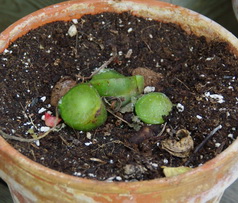 The late fall vegetable garden still yields more than enough quantity and variety to keep us well fed and to keep me busy in the kitchen. One of our winter favourites is spaghetti and the garden produces most of the ingredients for Ken’s famous spaghetti sauce. I do buy canned tomatoes, simply because of the quantity required. It is a day long project to slice, dice, stir, package and freeze but on a cold January night when we want a quick hearty meal it is sure worth the effort.
The late fall vegetable garden still yields more than enough quantity and variety to keep us well fed and to keep me busy in the kitchen. One of our winter favourites is spaghetti and the garden produces most of the ingredients for Ken’s famous spaghetti sauce. I do buy canned tomatoes, simply because of the quantity required. It is a day long project to slice, dice, stir, package and freeze but on a cold January night when we want a quick hearty meal it is sure worth the effort.The Tuberous begonias have been put to bed. The frost hadn’t quite done them in but they were getting pretty sad. Cut them back to soil level and dig out the tubers. Let the soil dry on the tubers and then gently remove it and store in a cool (not cold) dark spot 12 -14C would be ideal. New garden tools arrive in my tool shed with some regularity, most sent by suppliers that would like me to try them and then tell the world how wonderful they are. The Assistant Gardener wonders why they bother; something about me being rather set in my ways and resistant to change. I have no idea what she is talking about. I have an old hoe that has been in my family for at least 2 or 3 generations and it has a wonderful small head and has always been my tool of choice for weeding and for cultivating small spaces. It has been left in the shed during the great clean up of the Asparagus beds. I have been trying a new tool, the Cobrahead for a year or so. Originally had the short handled version, quite useful but this year used the new long handled version and it is doing a very good job and the old family hoe is spending more time in the shed. Full disclosure, they gave me one to try for free. Always a gamble on a supplier’s part because I have no hesitation in telling when I discover the latest high priced junk. The front page of Gardening-enjoyed has a new look. Every week, if I can keep it up, there should be a new picture illustrating that weeks primary garden activity. You can just go there and see what I’m doing and maybe get a hint about what your own garden activities might include. This is followed by links to new and topical pages that you might find interesting now. Questions My newsletter subscribers get to ask me questions. Just ‘reply’ to the email newsletter. It is always interesting to read the questions; mostly to see if I actually can answer them or if I have to wade into the textbooks to research the answers. If that happens then we all learn something. Lisa Asks?. Hey Ken, Question regarding my hydrangea. It is healthy and leafy but has hardly produced flowers in the last 6 years. What can I do to make it flower. When should I prune and how severe? Thanks! Ken Answers! There are so many new varieties of Hydrangea being developed over the past few years that I cannot keep up. I have several of them growing in my garden. Some have bloomed, some have not. Some species of Hydrangea bloom on the current years growth and can be pruned to the ground in the fall. Others bloom on old growth and should be pruned just after they bloom. Hard to do when they don’t bloom at all. It seems that Hydrangea, which was always a bit shade tolerant and I have planted several of new trial ones there, now has new varieties that require considerable sunlight in order to bloom properly. Your question has adjusted my writing priorities. I have been working on an in depth look at the many new types of hydrangea and I now hope to finish that and post it to gardening-enjoyed in the near future. Stay tuned and try to remember what type of Hydrangea you have. 111 Trent St. W. Whitby ON L1N1L9 |
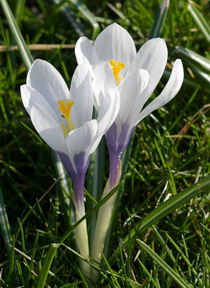 I have received a wonderful package of
I have received a wonderful package of 